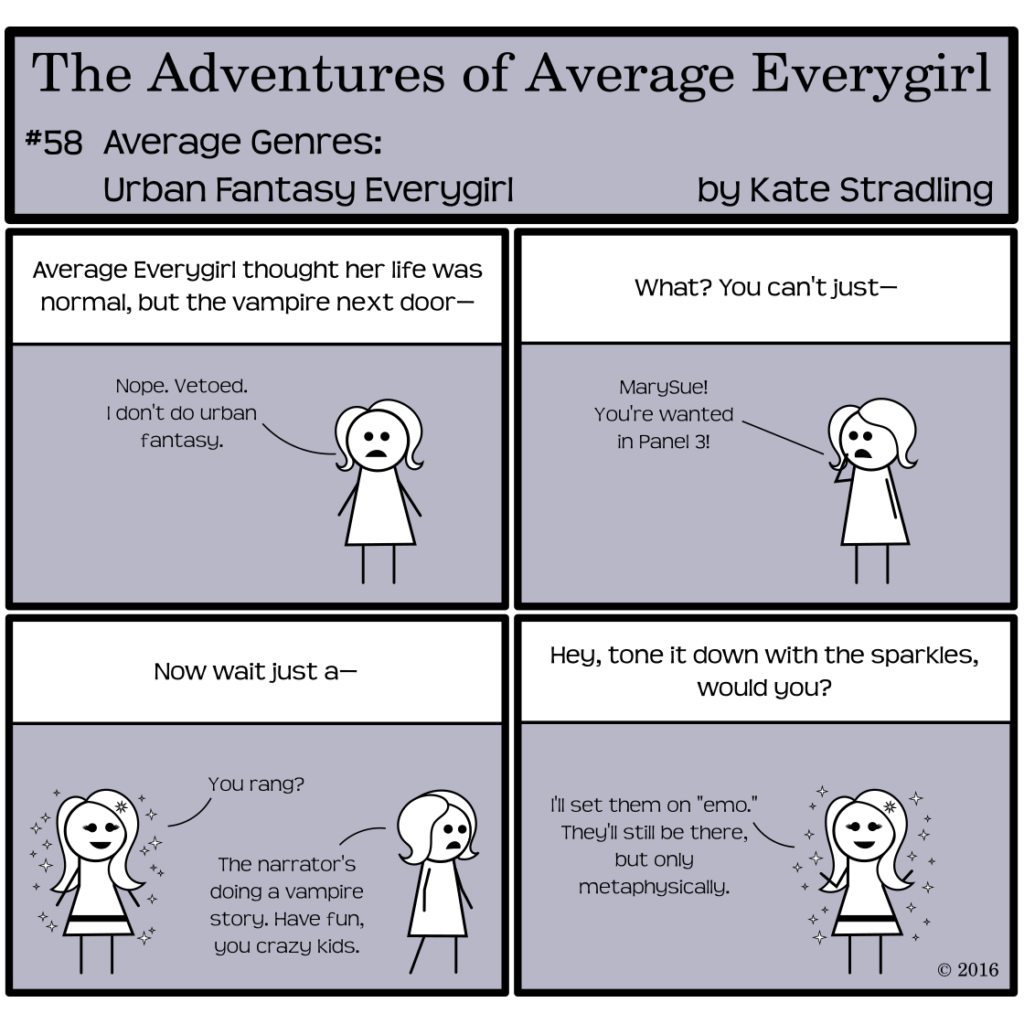
Sheesh, MarySue. You have to earn your sparkles in urban fantasy. You can’t just show up with them.
Lest anyone worry that I’m about to delve into the many nuances of werewolves and vampires and werepires¹ and whatnot, this week’s series actually bounces through a handful of sub-genres. Urban fantasy, with its gritty atmosphere and edgy feel, gets the first whack.
That Urban Fantasy Vibe
I’m not going to say that all urban fantasy heroines are MarySues, but many of them do tend to lean that direction. There’s definitely a formula at play: socially awkward, seemingly normal girl enters a new environment, only to be singled out by supernatural forces.
Maybe she’s secretly one of them. Maybe she’s a Chosen One destined to destroy or to save them. Or maybe she just smells nice.
Whatever the catalyst, she gets drawn into a coexisting society filled with danger and intrigue and…
Yes. Lurrrrrrrrrrrrrrrrrrrrrrrrrrrrrve.
Because you know when you pick up that book with its cool-toned cover and Gothic title font that there’s a lurve story embedded within.
(I’m not going to call it a love story. Sorry, but fiction rarely reaches that ideal.)
Genre Expectations
The heroine, typically, is an ingenue, unversed in the ways of this supernatural culture. Often she’s an avatar for the reader, so her lack of knowledge makes sense. She and the reader receive enlightenment together, a dual initiation into the new-found underworld.
Except that the reader comes into the story expecting the supernatural encounters, whereas the heroine is always taken by surprise. Her supernatural love interest (because he couldn’t possibly be normal) guides her through the transition. Sometimes she experiences the whole gamut of grief—denial, anger, bargaining, depression, acceptance—as she reconciles her newly acquired knowledge with her former worldview.
It’s all very dramatic. And of course, in the end, she integrates into the shadow-ranks. (But good shadows, you know. The hot, sexy monsters, not the icky, slimy ones.)
Common Vistas
The urban fantasy setting is always someplace you could find on a map: London, Paris, New York, Seattle. Only, it’s a gritty, edgy version of these places, because “urban” brings gritty, edgy imagery to mind. Night plays a huge role in this genre, mostly because supernaturals such as vampires and werewolves tend to avoid daylight.
And probably because the bald light of day renders such fantastic creatures ridiculous. (Go on. Tell me you haven’t envisioned monsters in the quiet, bumping night, only to scoff at yourself the next morning for such lunacy. I’m the only one? Whatevs.)
The human psyche has an inborn affinity for superstition, I think, but our carefully organized modern world with its scientific description for every tiny creature and event precludes such indulgence. Tales of shadow-lurking demons, passed through centuries of folklore, find a surprisingly natural refuge in big cities and small towns alike, though. There’s always something beyond our horizon of knowledge, something more to discover, something more to examine.
And fiction leads the way. So why not werewolves? Or vampires? Or werepires?
(Just kidding on the werepires. Were- literally means “man-” so the hybrid word is nonsensical. “Wolfpire” makes more sense, and “manpire” would sound better.)
¹Hat-tip to my cousin Melia for introducing me to this delightful portmanteau. A Google search of the term yields 26.3K hits, which makes me want to question humanity. But I’m sure there are sillier things afoot in pop culture, so I’ll let it lie.